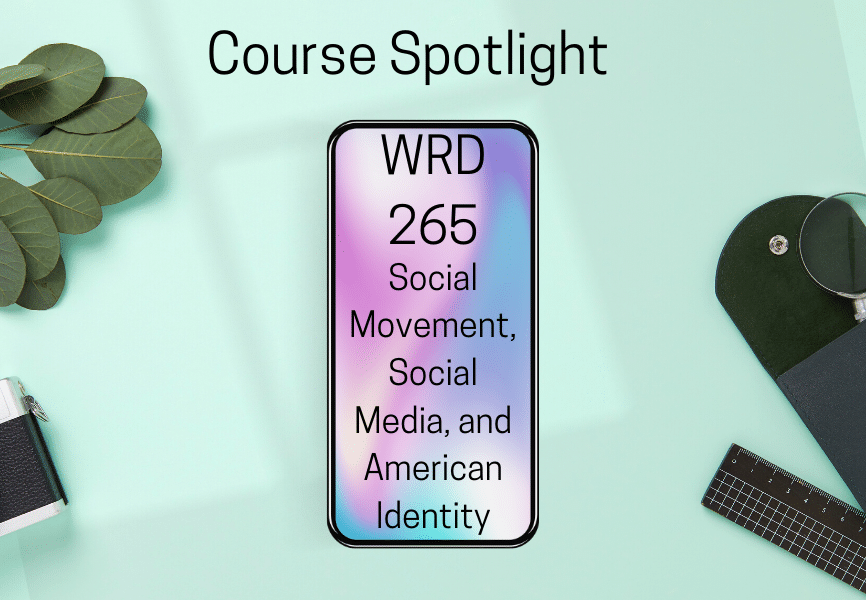Taking a look at the upcoming Autumn Quarter, we are highlighting the undergraduate course WRD 265 Social Movement, Social Media, and American Identities, taught by Professor Erin MacKenna-Sandhir. There is a prerequisite to the course — WRD 103 or HON 100. The course description states that the class looks at a range of things: “From civil rights and black power movements to women’s liberation and gay rights judicial activism, Americans have participated in social movements to protest precarious conditions and achieve a more livable life. This course introduces students to the study of social movements from a rhetorical perspective and explores ways that social media has reoriented American political participation by democratizing access to information, disrupting old models of power distribution, and allowing for rapid, broad coalition building and immediate moments of multimodal protest.”
We asked Erin some questions about how she plans to steer the direction of the course specifically.
Are there any main rhetorical situations you are looking to analyze or just a myriad of examples?
How do you teach a class on social movements when the world is on fire?!
I think it’s important that students’ own interests direct the class to a great extent. I’ve been teaching for almost twenty years, but last spring was the first time, in my experience, when student activists looked directly at their university professors and said, what you’re teaching doesn’t feel relevant right now. In response, Faculty Council , DePaul’s faculty-based governing body, voted to give students the option to end the quarter without completing final exams or final projects. That pushed all of us to scrutinize the content of our courses and its applicability to the problems students are encountering in the public realm. For me, it was an opportunity to develop practices responsive to students’ needs and interests but also a call to restore students’ hope for what social movements can achieve through rhetoric.
For the autumn quarter iteration of WRD 265, we will examine the rhetorical tropes deployed during the protests after the killing of George Floyd but also the rhetoric that coursed through the breach of the Capitol Building in January. We will seek to understand how the BLM protests of the last several years shaped the verdict in Officer Chauvin’s trial. We will seek to examine the deployment of terms like liberty and freedom in protests against mask mandates. We will seek to understand how youth activism in the Sunrise Movement acted as a centrifugal force pushing Democratic policy on climate change farther to the left and which narrative frames or rhetorical tropes were most effective in coalition building. We will seek to examine rhetorical tropes in the abolition movement and take note of how these intersect with one kind of feminist rhetoric, what Angela Davis calls abolition feminism, and yet diverge from another kind of feminist rhetoric, what Erica Meiners and Judith Levine call carceral feminism. We will also be moved to examine rhetoric from the social movements that students select to research for their term projects.
Are there any big projects you are planning on assigning or any big reading/topic you are hoping to cover?
I’m always inspired by students’ own projects and the forms of activism, formal and informal, that they’re taking up in their academic and public lives. As such, the course builds toward students’ own projects for which they choose a social movement they’re interested in and develop a protest artifact that could (theoretically) be deployed into the public sphere to advance one or more of their selected movement’s social, political, or ideological goals. Students select their topics by midterm, so for the second half of the term we are a community of learners with access to 20+ activist projects underway, which is very cool and always enlightening for me.
Last year, we read Zeynep Tufekci’s Twitter and Tear Gas: The Power and Fragility in Networked Protest and that might appear on the reading list again for AQ, but I’m also considering Angela Davis and Erica Meiners’ Abolition. Feminism. Now., which will be coming out this summer. Keeanga-Yamahtta Taylor’s book From #BlackLivesMatter to Black Liberation cogently names the moment and forces deeper engagement with the issues undergirding the BLM movement, so that’s likely to make its way onto the syllabus.
Is there anything you are looking forward to doing again with your students with Autumn classes being in person?
Yes! I’m looking forward to just being in the room together, but, on the other hand, there’s no particular ‘normal’ that I hope to return to if that means ignoring the lessons of the past year. For one thing, we will need to figure out how our classrooms can be restorative spaces that can help heal some of the social toxicity saturating our communities and traumatic losses of the pandemic era. When the pandemic started, I was scheduled to present at a Disability Studies conference, which of course was moved to Zoom, and my thinking about the pandemic was shaped by the many attendees who shared the ways that meeting online with its affordances and accommodations allowed for a broader set of engagements and catered to crip time in ways that the expectations of F2F meetings do not. On that basis, I’m always trying to think through ways to hack the traditional classrooms to better nurture students who might be more patient and plodding in their thought process or non-normative in their engagement practices.
Decentering the teacher is just a first step—giving students more power over how they interact and how they join in, while maintaining rigor and the force of communal, live-action participation, that’s the new dream.
Teachers cannot liberate their classrooms from outdated modes of operation on their own; we need to collaborate with our students if we are to create a transformative classroom culture that harnesses the lessons and restores lost hope from the past year.
